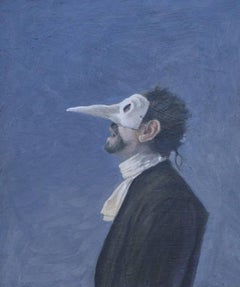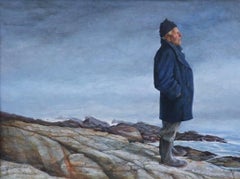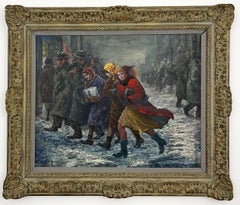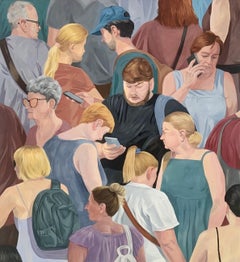Michael Kotasek Figurative Paintings
to
1
1
Overall Width
to
Overall Height
to
2
1
1
2
2
2
1
1
1
2
1
1
1
13
464
327
258
218
2
Artist: Michael Kotasek
Metaphysics
By Michael Kotasek
Located in Sag Harbor, NY
Awards
2013 Loring W. Coleman Award for Watercolor/ Allied Artists of America, 100th Annual Exhibition at the National Arts Club
2011 Mary Bryan Memorial Medal / Allied Artis...
Category
21st Century and Contemporary American Realist Michael Kotasek Figurative Paintings
Materials
Oil
Down Easter
By Michael Kotasek
Located in Sag Harbor, NY
Awards
2013 Loring W. Coleman Award for Watercolor/ Allied Artists of America, 100th Annual Exhibition at the National Arts Club
2011 Mary Bryan Memorial Medal / Allied Arti...
Category
21st Century and Contemporary American Realist Michael Kotasek Figurative Paintings
Materials
Egg Tempera
Related Items
Snow in the City, American Winter Scene Painting, Ornate Frame, Mid-Century Oil
Located in Marco Island, FL
American life is captured in this Clyde Singer painting, Snow in the City (1954), where he depicts an everyday moment in the city. An ordinary scene, of a group of women making thei...
Category
1950s American Realist Michael Kotasek Figurative Paintings
Materials
Oil, Board
$50,000
H 41 in W 36 in D 4 in
Desert 5 - Young Polish artist, Social commentary, Realistic tempera painting
By Anna Wardega
Located in Warsaw, PL
ANNA WARDĘGA-CZAJA
Graduated from the Painting Department at the Academy of Fine Art in Cracow, Poland in 2021. She's dealing with easel painting, wall painting as well as drawing. F...
Category
2010s Contemporary Michael Kotasek Figurative Paintings
Materials
Canvas, Egg Tempera
$4,793
H 63 in W 55.12 in
WPA "New Americans" Exceptional Antique 1941 WPA Exhibited Carnegie Painting
Located in Exton, PA
Monumental, important WPA painting by Percy Albee. The painting is oil canvas measuring 36" x 48". Titled verso "New Americans", this WPA painting was exhibited at the Carnegie Insti...
Category
1940s American Realist Michael Kotasek Figurative Paintings
Materials
Oil
$4,800 Sale Price
56% Off
H 40 in W 52 in D 2 in
Mid Century Figurative Portrait of a Boy with Toy Car
By Ralph Edward Joosten
Located in Soquel, CA
Realistic mid century portrait of a boy playing with an antique toy car by Ralph Joosten (American, 1928-2009). Signed "R. Joosten" in the lower left ...
Category
1960s American Realist Michael Kotasek Figurative Paintings
Materials
Canvas, Oil
$1,000 Sale Price
20% Off
H 24 in W 20 in D 0.75 in
Americana Winter Scene Ice Skaters Mid-Century- Norman Rockwell America
By Charlotte Sternberg
Located in Miami, FL
This charming rural winter scene of ice skaters fully displays Norman Rockwell's America, but it was painted by female artist Charlotte Joan Sternberg. She combines the mid-century A...
Category
1950s American Realist Michael Kotasek Figurative Paintings
Materials
Egg Tempera
$6,500
H 15.75 in W 19.5 in
Doctor's Office. Mid-Century American Scene Oil Painting Youngstown, OH.
Located in Marco Island, FL
An anxious moment waiting to see the doctor is depicted by Clyde Singer in this quiet and still painting. Entitled Doctor's Office (1949), Singer paints a moment of anticipation and...
Category
1940s American Realist Michael Kotasek Figurative Paintings
Materials
Oil, Panel
Along Central Park. New York City Street Scene Original Oil Painting.
Located in Marco Island, FL
New York City scene of two women walking down a sidewalk with a park in the background, in the foreground a man is walking a small dog. American life is captured in this Clyde Sing...
Category
1970s American Realist Michael Kotasek Figurative Paintings
Materials
Masonite, Oil
$13,000
H 20 in W 24 in
"Study for Long Beach" WPA American Scene Social Realism Modernism Ashcan
Located in New York, NY
"Study for Long Beach" WPA Mid 20th Century American Scene Social Realism Modernism Ashcan
Daniel Ralph Celantano (1902-1980)
"Study for Long Beach"
8 x 10 inches
Oil on artist bo...
Category
1930s American Realist Michael Kotasek Figurative Paintings
Materials
Oil, Board
Industry and Commerce
Located in Los Angeles, CA
This mural study is part of our exhibition America Coast to Coast: Artists of the 1930s
Industry and Commerce, 1936, tempera on panel, 16 ½ x 39 ½ inches, signed verso “John Ballator, Portland Ore.” provenance includes: J.C. Penney Company, represented by Russell Tether Fine Arts Assoc.; presented in a newer wood frame
About the Painting
Industry and Commerce is a prime example of WPA Era muralism. Like a Mediaeval alter, this mural study is filled with icons, but the images of saints and martyrs are replaced with symbols of America's gospel of prosperity through capitalism. Industry and Commerce has a strong narrative quality with vignettes filling the entire surface. Extraction, logistics, design, power generation, and manufacturing for printing, chemicals, automobiles and metal products are all represented. To eliminate any doubt about the mural's themes, Ballator letters a description into the bottom of the study. Ballator also presents an idealized version of industrial cooperation, as his workers, lab-coated technicians and tie-wearing managers work harmoniously toward a common goal in the tidy and neatly designed environments. Although far from the reality of most industrial spaces, Ballator's study reflects the idealized and morale boosting tone that many mural projects adopted during the Great Depression.
About the Artist
John R Ballator achieved success as a muralist, lithographer, and teacher during the Great Depression. Born in Oregon, he studied at the Portland Museum Art School, the University of Oregon and at Yale University where he received a Bachelor of Fine Art. In 1936, Ballator was commissioned to paint a mural panel for the new Department of Justice Building in Washington DC, an important project that spanned five years with several dozen artists contributing a total of sixty-eight designs. Ballator completed murals for the St. Johns Post Office and Franklin High School, both in Portland, Oregon. He also contributed to the 1938 murals at Nathan Hale School in New Haven, Connecticut. During the late 1930s, Ballator taught art for several years at Washburn College in Topeka, Kanas, where he completed a mural for the Menninger Arts & Craft Shop before accepting a professorship at Hollins College...
Category
1930s American Realist Michael Kotasek Figurative Paintings
Materials
Tempera
Women's City Club, Youngstown, Ohio. American Historical Scene Painting.
Located in Marco Island, FL
An accomplished American Scene painter, Clyde Singer successfully captured everyday life during his long career. A unique aspect of American life is depicted in this painting, entitl...
Category
1940s American Realist Michael Kotasek Figurative Paintings
Materials
Oil, Board
$32,000
H 19 in W 27 in D 3 in
City Peril. Mid-Century American Urban Scene Oil Painting of Crime.
Located in Marco Island, FL
The danger of American life is captured in this Clyde Singer painting, City Peril (1958), where he depicts a moment in the city where a woman is targeted while walking. An accomplish...
Category
1950s American Realist Michael Kotasek Figurative Paintings
Materials
Oil, Board
$14,000
H 15.5 in W 13.5 in
Renaissance portrait
Located in IT
hand signed
original painting
contemporary masterpiece in best renaissance traditions
egg tempera on wood
22x18x3cm original painting is available
Category
21st Century and Contemporary Renaissance Michael Kotasek Figurative Paintings
Materials
Wood, Tempera, Egg Tempera, Digital
Michael Kotasek figurative paintings for sale on 1stDibs.
Find a wide variety of authentic Michael Kotasek figurative paintings available for sale on 1stDibs. If you’re browsing the collection of figurative paintings to introduce a pop of color in a neutral corner of your living room or bedroom, you can find work that includes elements of blue, purple and other colors. You can also browse by medium to find art by Michael Kotasek in paint, egg tempera, oil paint and more. Not every interior allows for large Michael Kotasek figurative paintings, so small editions measuring 10 inches across are available. Customers who are interested in this artist might also find the work of Derek Buckner, Willard Dixon, and Alex Roulette. Michael Kotasek figurative paintings prices can differ depending upon medium, time period and other attributes. On 1stDibs, the price for these items starts at $3,000 and tops out at $14,000, while the average work can sell for $8,500.



